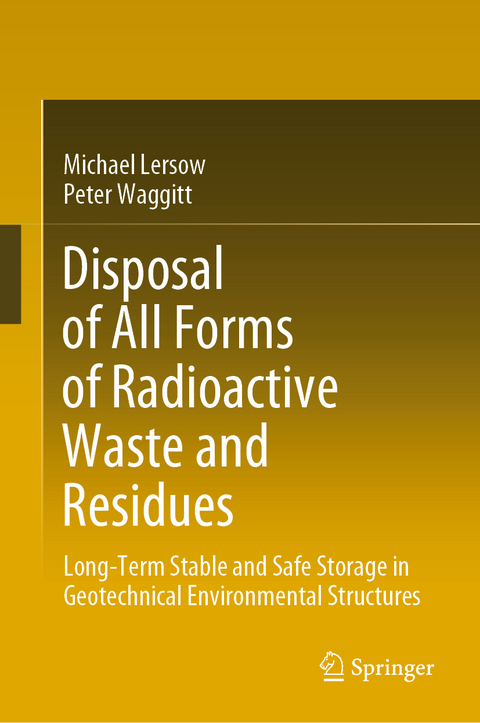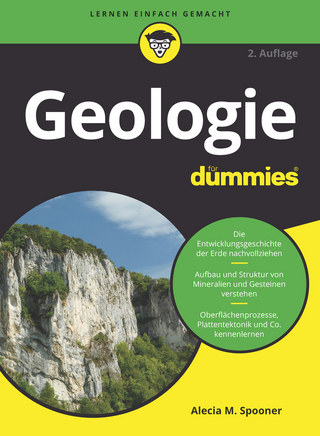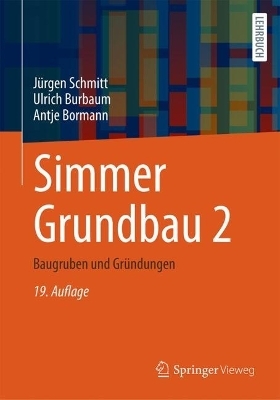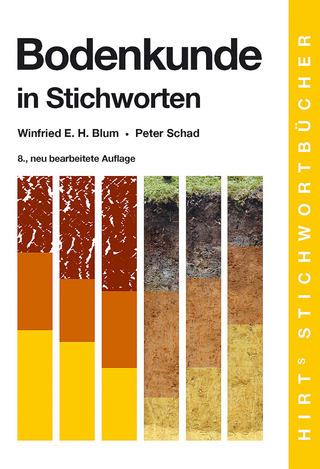
Disposal of All Forms of Radioactive Waste and Residues
Springer International Publishing (Verlag)
978-3-030-32909-9 (ISBN)
This book describes repository solutions for all types of radioactive waste and residues in different geotechnical repository structures. The focus is initially on existing or planned final disposal sites in Germany and the process of finding sites. However, international comparisons are drawn, especially to locations in the US. This affects both the repository structures and the legal requirements.
The radioactive substances considered include residues from uranium ore processing, as well as low and intermediate level radioactive waste up to heat generating, high level radioactive wastes, such as spent fuel and vitrified waste from reprocessing.
In order to evaluate the repository structures and their inventories, a dimensionless radiotoxicity index Ai / Fi [activity of radionuclide quantity (Ai) related to the exemption limit of radionuclide (Fi)] has been introduced. This gives the reader a well-founded overview of the degree of inconsistency in the handling of safetyrequirements for the respective geotechnical environmental structures. This creates the necessary transparency on this issue, which has not been previously available and is required by stakeholders today. The long-term security, the duration of the observation period and the certainty of the safety prognosis are also discussed in the book as well as the participation of subsequent generations in current and possible future repositories. This is vital as nuclear energy will continue to be used worldwide in the long term.
The international repository projects presented have all been subjected to the same evaluation criteria. This applies both to existing operational project as well as those about to be commissioned and the processes for seeking locations. Special attention has been paid to monitoring, both operational and long-term monitoring. This broad range of topics makes this book a very valuable read for both the interested public and the professional world.
Dr.-Ing. Michael Lersow has studied the disposal of radioactive waste and residues in different geotechnical environmental structures from various aspects and in significant positions. To name just a few examples: From 1980 to 1990 at the Technical University Bergakademie Freiberg he performed interdisciplinary and sponsored research on the storage of radioactive waste and closure systems and obtained his PhD in 1984. From 1990 to 1994,, following the peaceful revolution and reunification of Germany he was a member of the environmental committee of the Saxonian Landtag. There he was involved in the design of the supervision of the safekeeping and rehabilitation services of the legacies of SDAG Wismut. From 1995-2005 he worked in leading positions for the sustainable remediation and restructuring of abandoned mine sites of Central Germany. From 2005 he acted as CEO of the Wismut GmbH and WISUTEC GmbH where he was responsible for the remediation of the legacies of Uranium mining and processing of the Soviet-German stock company (SDAG) Wismut and for the design of a new landscape in Saxony and Thuringia. After this position from 2009 he worked, until his retirement in 2012, at the Federal Office of Radiation Protection, Department of Nuclear Waste Disposal dealing with the disposal of low and intermediate level radioactive waste including heat generating, high level radioactive wastes such as spent fuel and vitrified waste from reprocessing. Since 2007 Dr.-Ing. Michael Lersow has beenthe Chair of the working group "Tailings" of the German Geotechnical Society. He has more than 25 publications and is involved with various patents related to the modelling of geotechnical applications, abandoned mine site remediation, mining technologies and disposal of radioactive and toxic materials. He has won several awards: including the Constitutional Medal of the Free State of Saxony for his engagement in the reunification of Germany and the development of Saxon state and the Science Award, Class 1st, of the TU Bergakademie Freiberg for his research on the storage of radioactive waste and closure systems. Peter Waggitt, (FAusIMM,IEng, CEnv), is a soil scientist and environmental engineer who has worked on mine remediation issues in many parts of the world over the past 45 years or more. After early research on remediation of coal mines in the United Kingdom he was employed on a variety of environmental projects globally including natural resource inventory and rural development, often including elements of environmental impact assessment and landscape remediation, especially post mining. In 1988 Peter moved to settle in Australia working for the Office of the Supervising Scientist, a specialist unit within the Commonwealth (Federal) Government with responsibility to oversee the environmental aspects of uranium mining in the Alligator Rivers Region of northern Australia. The main sites were the mines at Ranger and Nabarlek as well as extensive exploration operations throughout Arnhem Land. The work also included working with others to prepare the remediation of the 13 small uranium mines in the abandoned South Alligator Valley uranium field and other sites in the Pine Creek geosyncline, including Rum Jungle. From 2004 to 2011 Peter worked with the International Atomic Energy Agency (IAEA), initially as a Waste Safety Specialist concentrating on remediation of former uranium mining and processing sites throughout the world, including major projects in the Central Asian states of the former Soviet Union, work which continues to this day. Later he was working with the Nuclear Fuel Cycle and Materials Section at IAEA, assisting member states to manage former uranium mining sites as well as helping them to develop local capacities in uranium mining regulation.
Introduction.- Radioactivity in waste and residues.- Fundamentals of final disposal of radioactive waste and residues in geotechnical environmental structures.- Disposal of waste with very low radioactivity.- Radioactive residues of uranium ore mining requiring special monitoring.- Disposal of radioactive waste of low and medium radioactivity.- Final disposal of radioactive waste with high radioactivity.- Long-term Safety of Geotechnical Environmental Structures for the final disposal of radioactive waste and residues in Germany.- Environmental Monitoring.- Summary/Outlook.
| Erscheinungsdatum | 27.11.2019 |
|---|---|
| Zusatzinfo | IX, 449 p. |
| Verlagsort | Cham |
| Sprache | englisch |
| Maße | 155 x 235 mm |
| Gewicht | 852 g |
| Themenwelt | Naturwissenschaften ► Geowissenschaften ► Geologie |
| Technik ► Elektrotechnik / Energietechnik | |
| Schlagworte | final disposal • Geotechnical environmental structures • Long-term environmental protection • Long term safe disposal • Nuclear waste repository • Nuclear waste storage • Radioactive waste disposal • Radioactive waste in Germany • Radioactive Waste Management • Radioactive waste solution • Safe storage of radioactive waste • Security of radioactive material • Structural Geology • Transparency in nuclear waste management • Waste residues |
| ISBN-10 | 3-030-32909-7 / 3030329097 |
| ISBN-13 | 978-3-030-32909-9 / 9783030329099 |
| Zustand | Neuware |
| Informationen gemäß Produktsicherheitsverordnung (GPSR) | |
| Haben Sie eine Frage zum Produkt? |
aus dem Bereich


